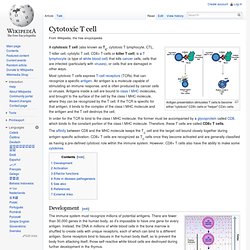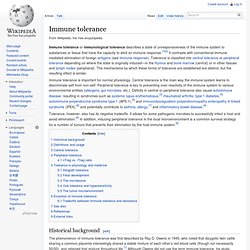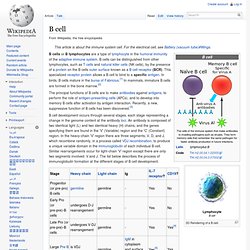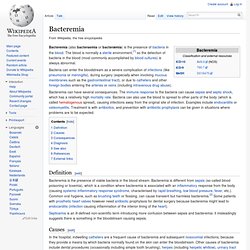

Passive immunity. Naturally acquired passive immunity[edit] Passive immunity is also provided through the transfer of IgA antibodies found in breast milk that are transferred to the gut of the infant, protecting against bacterial infections, until the newborn can synthesize its own antibodies.[4] Artificially acquired passive immunity[edit] Artificially acquired passive immunity is a short-term immunization achieved by the transfer of antibodies, which can be administered in several forms; as human or animal blood plasma or serum, as pooled human immunoglobulin for intravenous (IVIG) or intramuscular (IG) use, as high-titer human IVIG or IG from immunized donors or from donors recovering from the disease, and as monoclonal antibodies (MAb).

History and applications of artificial passive immunity[edit] A vial of diphtheria antitoxin, dated 1895 Antibody therapy is also used to treat viral infections. Cytotoxic T cell. Antigen presentation stimulates T cells to become either "cytotoxic" CD8+ cells or "helper" CD4+ cells.

A cytotoxic T cell (also known as TC, cytotoxic T lymphocyte, CTL, T-killer cell, cytolytic T cell, CD8+ T-cells or killer T cell) is a T lymphocyte (a type of white blood cell) that kills cancer cells, cells that are infected (particularly with viruses), or cells that are damaged in other ways. Most cytotoxic T cells express T-cell receptors (TCRs) that can recognize a specific antigen. Γδ T cells. The antigenic molecules that activate γδ T cells are still largely unknown.

However, γδ T cells are peculiar in that they do not seem to require antigen processing and major-histocompatibility-complex (MHC) presentation of peptide epitopes, although some recognize MHC class Ib molecules. Furthermore, γδ T cells are believed to have a prominent role in recognition of lipid antigens. They are of an invariant nature and may be triggered by alarm signals, such as heat shock proteins (HSP). Innate immune system. The innate immune system, also known as the nonspecific immune system and the first line of defense,[1] is an important subsystem of the overall immune system that comprises the cells and mechanisms that defend the host from infection by other organisms.

The cells of the innate system recognize and respond to pathogens in a generic way, but, unlike the adaptive immune system (which is found only in vertebrates), it does not confer long-lasting or protective immunity to the host.[2] Innate immune systems provide immediate defense against infection, and are found in all classes of plant and animal life. They include both humoral immunity components and cell-mediated immunity components. Immune tolerance. Immune tolerance or immunological tolerance describes a state of unresponsiveness of the immune system to substances or tissue that have the capacity to elicit an immune response.[1][2] It contrasts with conventional immune-mediated elimination of foreign antigens (see Immune response).

Tolerance is classified into central tolerance or peripheral tolerance depending on where the state is originally induced—in the thymus and bone marrow (central) or in other tissues and lymph nodes (peripheral). The mechanisms by which these forms of tolerance are established are distinct, but the resulting effect is similar. Immune tolerance is important for normal physiology. Central tolerance is the main way the immune system learns to discriminate self from non-self. Peripheral tolerance is key to preventing over-reactivity of the immune system to various environmental entities (allergens, gut microbes, etc.).
Tolerance, however, also has its negative tradeoffs. Historical background[edit] T helper cell. The T helper cells (Th cells) are a type of T cells that play an important role in the immune system, particularly in the adaptive immune system.

They help the activity of other immune cells by releasing T cell cytokines. They are essential in B cell antibody class switching, in the activation and growth of cytotoxic T cells, and in maximizing bactericidal activity of phagocytes such as macrophages. Regulatory T cell. The regulatory T cells (Tregs), formerly known as suppressor T cells, are a subpopulation of T cells which modulate the immune system, maintain tolerance to self-antigens, and abrogate autoimmune disease.

Mouse models have suggested that modulation of Tregs can treat autoimmune disease and cancer, and facilitate organ transplantation. B cell. 3D Rendering of a B cell.

The principal functions of B cells are to make antibodies against antigens, to perform the role of antigen-presenting cells (APCs), and to develop into memory B cells after activation by antigen interaction. Recently, a new, suppressive function of B cells has been discovered.[3] When the B cell fails in any step of the maturation process, it will die by a mechanism called apoptosis, here called clonal deletion.[6] B cells are continuously produced in the bone marrow. When the B cell receptor, on the surface of the cell, matches the detected antigens present in the body, the B cell proliferates and secretes a free form of those receptors (antibodies) with identical binding sites as the ones on the original cell surface. After activation, the cell proliferates and B memory cells would form to recognise the same antigen. Immune system. The immune system is a system of biological structures and processes within an organism that protects against disease.

To function properly, an immune system must detect a wide variety of agents, known as pathogens, from viruses to parasitic worms, and distinguish them from the organism's own healthy tissue. In many species, the immune system can be classified into subsystems, such as the innate immune system versus the adaptive immune system, or humoral immunity versus cell-mediated immunity. Pathogens can rapidly evolve and adapt, and thereby avoid detection and neutralization by the immune system; however, multiple defense mechanisms have also evolved to recognize and neutralize pathogens. Even simple unicellular organisms such as bacteria possess a rudimentary immune system, in the form of enzymes that protect against bacteriophage infections.
Other basic immune mechanisms evolved in ancient eukaryotes and remain in their modern descendants, such as plants and insects. Bacteremia. Bacteremia (also bacteraemia or bacteræmia) is the presence of bacteria in the blood.

The blood is normally a sterile environment,[1] so the detection of bacteria in the blood (most commonly accomplished by blood cultures) is always abnormal. Bacteria can enter the bloodstream as a severe complication of infections (like pneumonia or meningitis), during surgery (especially when involving mucous membranes such as the gastrointestinal tract), or due to catheters and other foreign bodies entering the arteries or veins (including intravenous drug abuse). Bacteremia can have several consequences. The immune response to the bacteria can cause sepsis and septic shock, which has a relatively high mortality rate. Infective endocarditis.
Infective endocarditis is a form of endocarditis, or inflammation, of the inner tissue of the heart (such as its valves) caused by infectious agents. The agents are usually bacterial, but other organisms can also be responsible. Normally, blood flows smoothly through these valves. If they have been damaged - from rheumatic fever, for example - the risk of bacterial attachment is increased.[1]
Myocarditis. Myocarditis or inflammatory cardiomyopathy is inflammation of heart muscle (myocardium). Myocarditis is most often due to infection by common viruses, such as parvovirus B19, less commonly nonviral pathogens such as Borrelia burgdorferi (Lyme disease) or Trypanosoma cruzi, or as a hypersensitivity response to drugs.[1] The definition of myocarditis varies, but the central feature is an infection of the heart, with an inflammatory infiltrate, and damage to the heart muscle, without the blockage of coronary arteries that define a heart attack (myocardial infarction) or other common noninfectious causes.[2] Myocarditis may or may not include death (necrosis) of heart tissue.
It may include dilated cardiomyopathy.[1] Because a definitive diagnosis requires a heart biopsy, which doctors are reluctant to do because they are invasive, statistics on the incidence of myocarditis vary widely.[1] The consequences of myocarditis thus also vary widely. Signs and symptoms[edit] Cat scratch disease. Cat scratch disease (CSD), also known as cat scratch fever,[1] Teeny's Disease,[1] inoculation lymphoreticulosis,[1] and subacute regional lymphadenitis,[1] is a common and usually benign infectious disease caused by the fastidious[2] intracellular gram negative bacterium Bartonella henselae or Bartonella quintana.[3][4] It is most commonly found in children following a scratch or bite from a cat[3] within about one to two weeks.
Signs and symptoms[edit] Research Review: Could Green Tea Actually Be Bad For YOU? Green tea has received a lot of positive media attention in recent years. But is it really good for everyone? Not necessarily. There is a group of people for whom green tea may be hazardous. And given green tea’s popularity these days, it’s critical to share this information with anyone interested in health. Green tea has a wealth of research behind it demonstrating a number of health-promoting benefits including anti-inflammatory, anti-carcinogenic and antioxidant properties. Many of green tea’s benefits are due to its effects on the immune system, which is also where it can cause problems. But before telling you how green tea impacts the immune system, let’s take a quick look at a simplified version of how it works. Should you banish this harmless-looking substance from your pantry?
Th1/Th2 balance: the hypothesis, its limitations, and implications for health and disease.